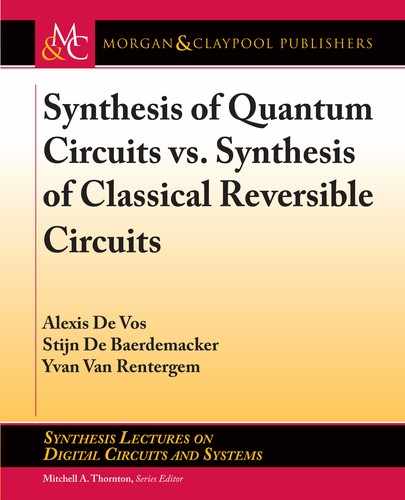60 3. BOTTOM-UP
consisting merely of uncontrolled PHASORs and controlled PHASORs, is obviously represented by a
2
w
2
w
unitary diagonal matrix with first entry equal to 1. e n n unitary diagonal matrices
with upper-left entry equal to 1 form a group ZU(n), subgroup of U(n). We thus can say that an
arbitrary PHASOR circuit is represented by a ZU(2
w
) matrix. e converse theorem is also valid:
any member of ZU(2
w
) can be synthesized by an appropriate string of (un)controlled PHASORs
(proof being not laborious).
To summarize, the study of NEGATOR and PHASOR circuits leads to the introduction of two
subgroups of the unitary group U(n):
• the subgroup XU(n), consisting of all n n unitary matrices with all of their 2n line sums
are equal to 1 and
• the subgroup ZU(n), consisting of all n n diagonal unitary matrices with upper-left entry
equal to 1.
ese subgroups have some properties similar to the three properties of XU(2) and ZU(2), dis-
cussed in the previous section. For example, the intersection of XU(n) and ZU(n) is minimal as
it is the trivial subgroup 1(n) consisting of a single matrix, i.e., the n n unit matrix. However,
some properties are not inherited. (See end of Section 3.6.)
3.5 THE GROUP ZU(n)
An arbitrary member Z of ZU(n) is of the form
0
B
B
B
B
B
@
1
e
i˛
2
e
i˛
3
:
:
:
e
i˛
n
1
C
C
C
C
C
A
D diag.1; e
i˛
2
; e
i˛
3
; : : : ; e
i˛
n
/ :
Because of the identity
diag.1; a
2
; a
3
; : : : ; a
n1
; a
n
/ D diag.1; a
2
; 1; : : : ; 1; 1/ diag.1; 1; a
3
; : : : ; 1; 1/ : : :
diag.1; 1; 1; : : : ; a
n1
; 1/ diag.1; 1; 1; : : : ; 1; a
n
/ ;
it is clear that the group ZU(n) is isomorphic to the direct product U(1)
n1
and thus is an
.n 1/-dimensional Lie group.
Of course, ZU(n) is a subgroup of DU(n), the n-dimensional group of diagonal unitary
matrices, an arbitrary member D of DU(n) being
diag.e
i˛
1
; e
i˛
2
; e
i˛
3
; : : : ; e
i˛
n
/ :
..................Content has been hidden....................
You can't read the all page of ebook, please click here login for view all page.
